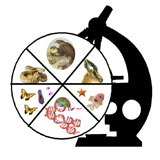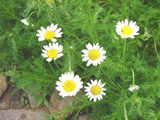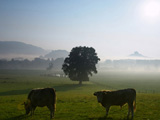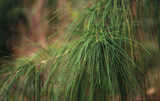Medicinal plants
Dynamic plants for farming and healing
Editor‘s note
What we eat is what our bodies become. It is interesting how the principles of treatment of humans are also applicable for plants. Alternative therapies for plants are now coming to the fore. This article explores such a bold experiment in health care at the roots...
(This article was published in 2003).
Background
Rudolf Steiner (1860-1925), founder of the anthroposophic movement, has also been the initiator of a school of organic or ecological farming, i.e. biodynamic (BD) farming. Steiner’s lectures on agriculture were given in 1924 to a circle of farmers, in response to their request for his guidance in counteracting loss of soil fertility, seed vitality and cattle health, and in his concern for nutritious food. From then on, BD farming and research took off, but in very restricted circles. During the Nazi reign in Germany, BD farming and anthroposophy in general, had to go ‘underground’, and this and the ridicule that any occult philosophy receives in modern day Europe, might have been reasons for the secretive and reserved atmosphere surrounding BD agriculture. It is only in the last twenty years, with world-wide concerns for ecological survival and interest in organic farming growing, that BD farming has gone strongly public, and that its food produce of superior quality has received the appreciation it deserves.
While a few scattered BD plantations have existed in India since the eighties, it was only in the nineties that BD farming became a player in the growing organic farming movement of India. The main impetus came from the antipodes of Europe, New Zealand.
Biodynamic farming — a short summary
BD farming is a fairly labour-intensive organic farming approach which assures long-term soil fertility and health of cattle, and provides good yields with top quality food produce. Naturally, it cannot prosper without knowledge and skillful use of other, basic organic farming practices, such as crop rotation, multi -cropping, composting, mulching, green manuring with the aid of legumes, the use of companion plants and trap plants, the use of rock dust etc. In order to become a successful BD farmer it may not be necessary to comprehend everything that Steiner has said on farming. It will be enough to apply the ‘technique’, with skill and commitment, and, if possible, understanding and love.
In practice, BD farming is defined by the following elements :
Firstly, by the use of several specific preparations based on manure, quartz, plants and other natural ingredients that have undergone elaborate and lengthy processing in order to exert their fullest benefit. The final preparations are used as sprinkles and sprays and as inoculants for compost, liquid manures, and derived farming inputs. These preparations are not only used in small to minimal amounts, but in many instances also processed in ways which are comparable to, or indeed are, homeopathic potentizing.
Secondly, by the recognition that not only sun and seasons are decisive for plant growth and cultivation, but also the more subtle influences as the moon, planets and from star constellations farther away in our galaxy.
A few examples may be given to illustrate the character of BD farming inputs. The fundamental preparation is so-called horn manure whose effects are: increase in earthworm activity, in activity of humus-forming bacteria, porosity, crumb structure, clover nodulation, and root penetration. Horn manure is made in the following way: fresh cow dung, preferably from a well-fed lactating cow, is placed into a cow horn and buried in the ground, at or soon after the autumn equinox. It is kept in the ground throughout the winter months and retrieved just before or at the spring equinox. By this time, it has been transformed into humus with a pleasant earthy smell. Only a small quantity, about 25 grams mixed into one bucket of water, is required for an application on one acre of land. Prior to application, the horn manure is mixed with clean water, preferably rainwater, by a vigorous stirring for one hour, in alternating clockwise and anti-clockwise movements, creating a deep vortex with each stirring cycle. Then it is applied in the form of big droplets, without trying to achieve coverage, but rather relying on the ‘radiating’ power of the horn manure. The best time for this procedure will be late afternoon in a descending moon phase (which is something else than a waning phase).
It is likely that such voodoo-like activity will be received by the modern Western mind with disbelief, suspicion or ridicule. However, field research extended over more than two decades, has demonstrated that BD practices are the most effective method in assuring long-term soil fertility at high nutrient and humus levels, besides the fact that short-term effects are anyway perceptible and do convince the practicing farmer to use and stick to the method. The cow, its dung, and its horn receive an extraordinary respect within BD farming. While agriculture in general does not concern itself with the function of the cow’s horn, or regards it as an instrument for attack and self-defence, Steiner has emphasized that the horn is part of the digestive system, so to speak, that it re-directs forces of digestion into the cow’s belly, and thus helps to make digestion complete. Zoology has come to understand that the sinuses of a cow’s skull, which are generally large, are in direct continuation with the interior of the horns, which are nothing but thickened skin. The stomach pouches of the cow do not actively secrete any digestive juices; there the food is fermented bacterially and then belched up again for rumination. The belched-up gases are, indeed, circulating through the sinuses and horns while the animal munches its food for the second time. Steiner’s insight is thus confirmed. Further, dehorning of cows has become routine in modern large-scale cattle husbandry. As the horn is not recognized as having any significant function, dehorning is not believed to have any effect on the well-being of the cow, its general health, or on the quality of the milk. However, recent research has shown that samples of blood, urine, or milk taken from a cow with horns, definitely differ from those taken from a dehorned cow (1). This has been demonstrated with the help of a visualising qualitative test; what the test results exactly express, cannot yet be verified scientifically, but the contested difference in quality is there.
Other BD preparations are used in much smaller doses than horn manure. In the case of horn silica, the amount of the size of a pinhead is enough for one acre of land. Its effect on photosynthesis and foliage development can be seen within a few days, and its effect on the ripening and sweetness of the matured fruit or crop is there to be tasted. As in the case of Samuel Hahnemann, the founder of homeopathy, who coined the term potentizing — in BD farming too, we have to accept that effects of small and minimal doses of processed substances; stirred, shaken, potentized — cannot be explained by calculation of gross-physical inputs and outputs, but by an assumed action of non-material forces only, of ‘prāṇic ‘ or ‘etheric’ or life-forces and of forces of a higher order. Occult insight into the forces of nature may well be able to guide scientific research and technical development (2).
One of the plants used for BD compost preparations is yarrow, Achillea millefolium. That yarrow is a truly ‘dynamic plant’, can be seen from the following observation from New Zealand. Yarrow grown in soil which had no measurable amounts of selenium — one of the essential trace elements for plant growth — was harvested and used for making a liquid manure. Nevertheless, the analysis of the matured liquid manure showed the presence of selenium (3). Thus, the statement in BD teaching that yarrow is able to attract or ‘catch’ trace elements, seems to be justified.
Another plant recommended by Steiner is chamomile, Matricaria chamomilla. In European home-cures, chamomile is known as a medicine for stomach ache — in the form of a tea, and as an application for wound inflammation. Chamomile tea is almost something like an archetype of herbal medicine comparable to tulsī in India. Its smell, taste, and atmosphere are pleasing, soothing, and reassuring to the sick. In times without refrigeration, chamomile was also used to preserve meat. The efficacy of this practice can be demonstrated quite dramatically within a minute. If you throw a handful of dried chamomile flowers onto a heap of putrefying meat or offals giving an offensive stink, the odour will disappear within a few seconds. The capacity of this little flower to preserve meat, and its remedial effect on a child’s bad tummy, may be due to the same property, which again might be in line with the one that Steiner wanted to utilize for the farmer’s manure heap, the capacity to counteract putrefaction — with its concomitants of stink and flies — and to induce orderly fermentation.
And at last, some comments on the relevance of plant growth attributed to lunar, planetary and stellar constellations. Biology knows more than six hundred organisms to have feeding and reproductive patterns in accordance with the rhythms of the synodic moon (the 29.5 days cycle of the moon phases). Many plants have been shown to respond in their metabolism to lunar rhythms, in germination and water uptake of seeds, in root growth, respiration, growth rate, absorption of nutrients, DNA formation and formation of cytokinin. Tree trunks expand and contract in conjunction with the cycles of the tides, and forest guards of all continents traditionally have been timing their tree felling in recognition of similar observations (4). Middle-European forestry is well documented, and records show that particular tree species favour, to conclude from their germination and growth rates, particular planetary rhythms. All these influences might be subtle and less significant than the sun’s more obvious powers, but to repudiate them must be regarded as unscientific.
When in the early nineties of the last century, Peter Proctor from New Zealand, a reputed international adviser on BD agriculture, started coming to India and teaching BD, he was pleasantly surprised by the openness of the Indian mind. Further, he was happy to realize that the Indian farmer has not lost touch with the basics of his professional world i.e. with soil, humus, compost and cattle dung, and that there exist within Indian and Hindu culture, elements which are conducive to the acceptance of BD practices, one of them being the worship of the cow, and another being the existence of rituals in tune with the cycles of nature, e.g. agnihotra. By now, BD farming has taken strong roots in India, and Peter Proctor would judge that amongst Indian BD farms, we can find some of the world’s best. To the factors contributing to the spread of BD teaching in India, besides an openness of mind and being in touch with soil and manure, we might add the respect which BD farming gives to the cow; readiness of the general mentality to respect astronomical factors; the fact that the speed of tropical metabolism renders early perceptible results; and maybe the life energies of Mother India which seem to be flowing strongly.
Research in substitutes for ‘dynamic plants’
In regard to the plants used for composting, Rudolf Steiner said in the course to farmers:
“Let me emphasize right from the beginning that if one or the other of them [the specific plants] is difficult to find in a given area, it is possible to replace it with certain other things.”
He thus explicitly encouraged search for substitutes of the plant species and materials which he recommended for the BD preparations. The only exception he made was for stinging nettle, Urtica dioica. In reference to this European weed, he remarked that,
“it would be next to impossible to find a substitute for it.”
He spoke of the stinging nettle as a “great boon“... “in fact, the greatest benefactor of plant growth“, and repeated that “it can hardly be replaced by any other plant “ (5).
Ehrenfried Pfeiffer (1899-1961), one of Steiner’s followers and research associates, created the term ‘dynamic plants’. He wrote:
“Dynamic plants we call those which influence their surroundings in a specific way so that other plants change their properties or that a soil changes its character. But this influence has to go farther than the mere competition between minerals, water and light” (6).
And he continued by citing examples from his research trials.
In New Zealand and Australia, BD practitioners have been intelligent and courageous enough to innovate. They substituted casuarina foliage for horsetail, Equisetum arvense, which is made into a tea or a liquid manure and used to prevent plant diseases due to excess humidity, i.e. as an anti-fungal preparation. In India and some other countries, some minor changes — changes in the varieties of a species — have been introduced without any loss of efficiency of the system: Urtica dioica has been replaced by Urtica parviflora and Quercus robur by Quercus dilatata.
When I, as a fresh graduate in medicine, asked a guiding elder friend how to step beyond book-learning and learn healing from within, I was told that I should have to find the song of the appendix in order to correct the wrong note of appendicitis. As long as we do not have direct occult insight into nature, and yet intend to do relevant research into the circumscribed field, it will be of advantage to have access to the following branches of knowledge and fields of experience: botany and plant biochemistry; geology and soil biology and microbiology; work with medicinal plants; work with plant-based pest repellents in farming and gardening; Āyurvedic scriptures on plants and their associations with the tridoṣas, guṇas, body organs, etc.; and alchemistic scriptures on relationships between plants, minerals, elemental beings, planets etc..
In line with neoplatonic tradition and alchemistic teaching, Paraclesus (1493-1541) had stated that there is one and the same essence behind iron (on the mineral and physical level), nettle (on the plant and pranic level) and Mars (on the mental or astral level). In anthroposophy, in a rather systematic fashion, the line of ‘associations’ is extended further to Tuesday — Mardi in French — as the day of the week, to the oak as the tree, to oats as the cereal, to the gall bladder as the body organ, to diamond as the crystal and red as the colour, to E as the vowel and C as the tone, and to Samuel from amongst the archangels. And Steiner made Urtica into a farming preparation, and iron metabolised by Urtica into a pharmaceutical preparation. In both fields of application, the actual use of a substance is, from the materialistic point of view, negligibly small or deliberately homeopathic. What Steiner wanted to provide with these preparations, was not a particular substance (the iron contents of nettle), but a capacity to optimally deal with a substance, and to deal with and balance forces, and to optimise their beneficial effects. The synthetic approach we are looking for consists of elements such as: a plant; its medicinal or culinary uses or its properties in gardening as, for example, a companion plant; its chemical contents and its association with minerals as well as with micro-organisms; its association with planetary or stellar constellations and rhythms; and one may add: its preferred eco-sphere and associated insect and animal life; its dependency on seasonal changes, its rhythm, its vibration, its music, and its note.
It might be of value to understand which plant is offered to which divinity of the Indian pantheon. It might also be helpful to utilize Mother’s comments on the messages of flowers. A plant’s roots obviously correspond to the earth element, its stem and leaves to the water element, its flowers to that of air and light, and its fruits and seeds to warmth and fire. In this context, the flower seems to develop at a border where ‘astral’ or mānasic (mental) forces — those of air and light — act on prāṇic (vital) forces and contribute to the colour and shape of the organism. What Mother has caught as a ‘message’ may be this imprint, translated into human language. Similarly to these messages being used to find new flower remedies, they could also be used as hints towards dynamic properties exploitable in farming. In our villages in Tamil Nadu, households like to cultivate a drumstick tree, Moringa oleifera. Its seed pods, flowers, and leaves are popular ingredients in curries, lentil dishes and vegetable dishes. The many-seeded pods are an excellent source of protein and the leaves of Vitamin A, and deficiencies in proteins and Vitamin A are amongst the most common and debilitating forms of malnutrition in the poor rural, hinterland. The Mother called the flower of Moringa, ‘hygienic organisation’ (7). Was she aware of the fact that in Senegal and Sudan, seeds of the drumstick tree have been traditionally used to purify muddy turbid water transforming it, by coagulation, into drinking water?
As India is extremely rich in medical knowledge and practice, represented by the medical systems of Āyurveda,Siddha, Unānī and traditional practices in all strata of society; as India is equally rich in plant life, in bio-diversity, in medicinal plants and in knowledge and experience of their medicinal use; as the Indian mind is open to findings of modern materialistic science, of fringe sciences and occult schools, India should be an ideal ground for some research into this field.
Those amongst our readers who have knowledge on relationships between plants, minerals, bodily organs, planets and cosmic influences, please come forward. And those who have some amount of clairvoyance or receive intuitive guidance in this field of knowledge, should be ready to guide our research.
References
1. Kulturgemeinschaft zur Fvrderung/Pflege des Biologisch-Dynamischen Lan-dbaus e.v. (Hrsg.). Die Kuh braucht ihre Hvrner! Maier-hvfen, Germany; 2002.
2. Dengel, Lucas. Biodynamic agriculture and homeopathy. Bangalore; 2002.
3. Proctor, Peter. Grasp the nettle. Auckland, New Zealand; 1997, p. 71.
4. Spiess, Hartmut. Lunar rhythms and plants. In: Biodynamics May/June 2000; 229.
5. Steiner, Rudolf. Spiritual foundations for the renewal of agriculture. Kimberton, USA; 1993, p. 93 & 98f.
6. Pfeiffer, Ehrenfried E. Weeds and what they tell. Kimberton, USA; 1970, p. 88.
7. The Mother. Flowers and their messages. Pondicherry; 1992, p.169.
Dr. Lucas Dengel lives at Grace, Auroville and is running a biodynamic farm.
Share with us (Comments,contributions,opinions)
When reproducing this feature, please credit NAMAH,and give the byline. Please send us cuttings.







